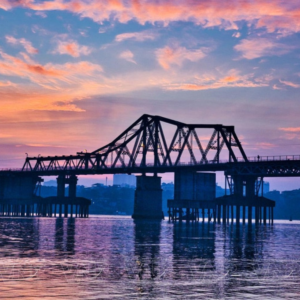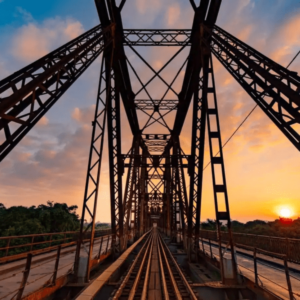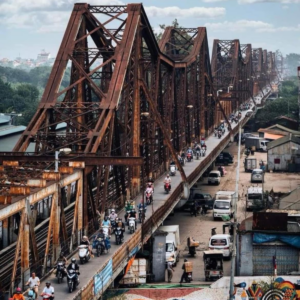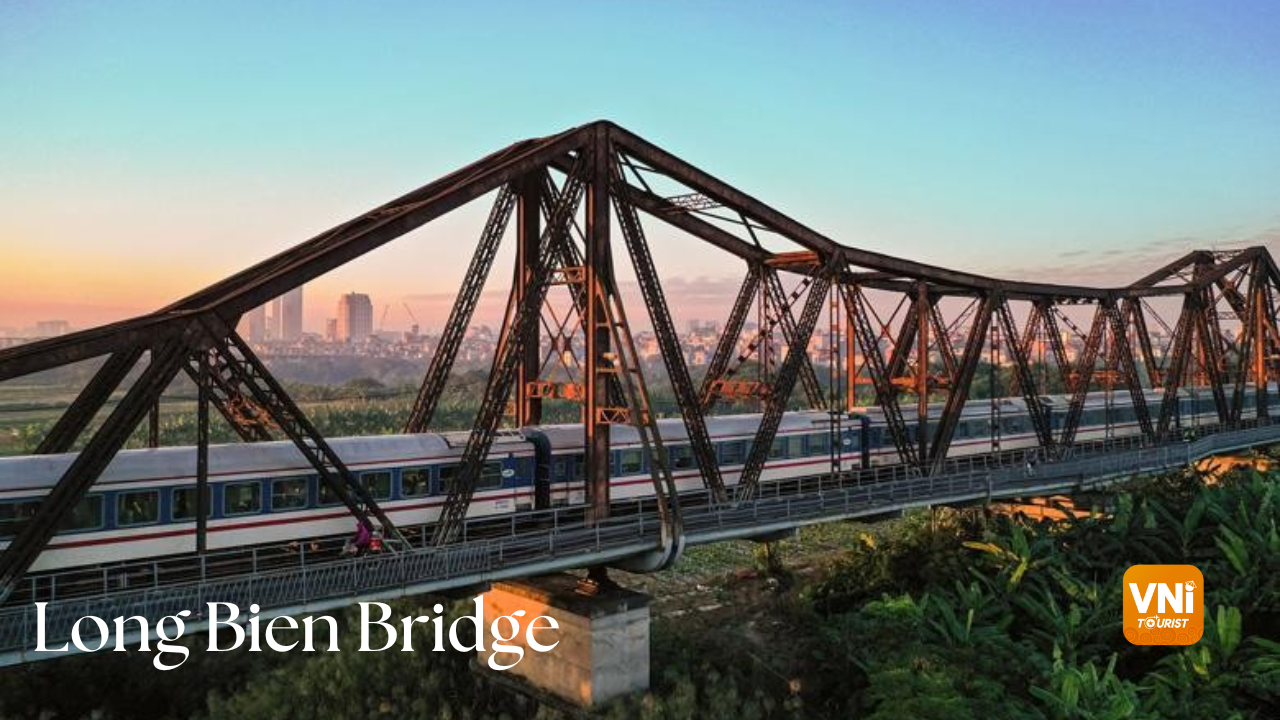Discover Long Bien Bridge – Hanoi’s Historical Icon
Explore Long Bien Bridge – A Journey Through Hanoi’s History
Spanning the Red River, Long Bien Bridge is a timeless symbol of Hanoi’s history, endurance, and charm. Built between 1899 and 1902 during the French colonial period, it was the first steel bridge across the Red River. For over a century, this iconic bridge has witnessed Hanoi’s many transformations and remains a must-visit destination for those seeking a unique travel experience in Vietnam.
About Long Bien Bridge

Long Bien Bridge, built between 1899 and 1902, is one of Hanoi’s most iconic landmarks and a symbol of the city’s resilience and history. Designed by the architects behind the Eiffel Tower, it was the first steel bridge across the Red River and one of the longest bridges in Asia at the time of its construction. Originally named Paul Doumer Bridge during the French colonial era, it connected Hanoi to important trade routes and played a significant role in the city’s development.
Throughout Vietnam’s history, Long Bien Bridge witnessed numerous key events. During the Vietnam War, it was heavily bombed but repaired time and again by the Vietnamese people, earning it the reputation of a bridge that refuses to fall. Its iron framework and wooden planks, though weathered by time, continue to stand strong as a testament to Hanoi’s enduring spirit. Today, Long Bien Bridge is more than a relic of the past; it’s a living part of the city, used daily by locals for commuting and transporting goods.
Walking along the bridge offers a unique blend of history, culture, and scenic beauty. The panoramic views of the Red River, vibrant farmlands, and the city skyline create a picturesque experience, especially at sunrise and sunset. For visitors, Long Bien Bridge is not just a place to pass through but a destination that tells the story of Hanoi’s past while offering a glimpse into its present-day life. It remains a favorite spot for photographers, history lovers, and anyone seeking an authentic connection to Hanoi’s soul.
Key Highlights of Long Bien Bridge
– Historical Significance
- Built between 1899 and 1902 by French architects, Long Bien Bridge was the first steel bridge to span the Red River and one of the longest in Asia at the time.
- It served as a crucial connection for transporting goods and troops during the French colonial period and Vietnam’s wars for independence.
- The bridge was heavily bombed during the Vietnam War, yet locals continuously repaired it, making it a symbol of Hanoi’s resilience.
– Unique Architecture
- Designed by the Architects of the Eiffel Tower, the bridge boasts a remarkable blend of French colonial design and early 20th-century engineering.
- Its iron framework, stone piers, and wooden pedestrian paths give it a rustic, authentic charm that stands out from modern bridges.
- Asymmetrical Structure: Unlike most bridges, Long Bien has a unique asymmetrical design, with separate lanes for pedestrians, bicycles, and trains.
– Scenic Views
- The bridge offers panoramic views of the Red River, fertile farmland, and the bustling urban landscape of Hanoi.
- Best Times to Visit: Early mornings for peaceful walks and stunning sunrise views; late afternoons for the golden light of sunset.
Why Visit Long Bien Bridge?
– A Living Historical Landmark
Step back in time as you walk across a bridge that has stood for more than a century. Built in 1902 by French architects, Long Bien Bridge has witnessed significant moments in Hanoi’s history—from the colonial era to wartime resilience and modern-day transformation.
- It was bombed multiple times during the Vietnam War but was always repaired by the local community, symbolizing the strength and determination of the Vietnamese people.
- Walking across the bridge, you can almost feel the stories it holds in its weathered iron and wooden planks.
– Scenic Views of Hanoi and the Red River
Long Bien Bridge offers breathtaking views of the Red River, Hanoi’s skyline, and the surrounding farmlands.
- Sunrise and sunset are the best times to visit for stunning photo opportunities and serene moments.
- The lush green fields and boats on the Red River create a peaceful contrast to the bustling cityscape.
– Authentic Local Experience
Unlike other tourist spots, Long Bien Bridge is a place where you can observe and engage with local life.
- Farmers transport fresh produce across the bridge to nearby markets.
- Street vendors sell traditional snacks like roasted corn and boiled sweet potatoes along the walkway.
- Cyclists, pedestrians, and even motorbikes share the bridge, creating a dynamic blend of old-world charm and modern-day utility.
– A Photographer’s Paradise
For photographers and Instagram enthusiasts, Long Bien Bridge is a dream location.
- The rusted iron structure, wooden pathways, and surrounding landscapes offer endless possibilities for creative shots.
- Each season brings a unique charm: misty mornings, golden sunsets, or blossoming spring flowers.
– Cultural Symbol of Resilience
More than just a bridge, Long Bien represents Hanoi’s resilience and spirit. Surviving bombings and natural wear, it stands tall as a reminder of the city’s ability to overcome challenges.
- It has become a symbol of pride for Hanoians, connecting generations with its enduring presence.

How to Visit
– Location
- Address: Long Bien Bridge spans the Red River, connecting Hoan Kiem District to Long Bien District in Hanoi, Vietnam.
- Proximity to Old Quarter: Just a short distance from Hanoi’s Old Quarter, making it an ideal stop on your city tour.
– Best Times to Visit
- Early Morning: Perfect for a peaceful walk with fewer people, beautiful sunrise views, and observing local life.
- Late Afternoon and Sunset: Capture stunning photos of the sunset over the Red River and enjoy the golden light reflecting on the bridge.
- Nighttime: Experience the quiet charm of the bridge under city lights.
– Getting There
1. By Taxi or Grab
- Convenience: The fastest and most comfortable way to reach the bridge from anywhere in Hanoi.
- Estimated Time: 10-15 minutes from the Old Quarter, depending on traffic.
2. By Bicycle or Walking
- For those staying in the Old Quarter or nearby, walking or cycling to the bridge is a scenic and enjoyable option.
- Tip: Walking across the bridge gives you the best experience, with plenty of opportunities to stop, take photos, and enjoy the views.
3. By Public Bus
- Several buses stop near Long Bien Market, which is located at the base of the bridge. This is a budget-friendly way to reach the area.
- Bus Routes: Check local bus routes that stop at Dien Bien Phu Street or near the Long Bien Station.
– Entry and Fees
- Entry Fee: Free for all visitors.
- Access: Open 24/7. You can visit at any time, but daylight hours are recommended for safety and better views.
Nearby Attractions – Explore the Hidden Charms Around Long Bien Bridge
– Long Bien Market – The Real Hanoi at Dawn
Located right under the bridge, Long Bien Market is one of Hanoi’s busiest and most fascinating wholesale markets.
- Best Time to Visit: Come at 4:00 AM or 5:00 AM if you want to experience the market at its liveliest. It’s a sensory overload of fresh produce, seafood, and flowers being traded in the early morning hours.
- Local Tip: Bring your camera! The market’s vibrant energy and colorful displays make for some incredible photos.
– Hanoi Old Quarter – A Blend of Tradition and Modernity
Just a short walk from Long Bien Bridge, the Old Quarter is where you’ll find a maze of ancient streets packed with shops, street food vendors, and historic homes.
- Eat Like a Local: Try Bun Cha (grilled pork with vermicelli noodles) at a small street-side eatery or grab a cup of traditional egg coffee at Café Giang.
- Stroll and Shop: The Old Quarter is the perfect place to buy handmade crafts, silk scarves, and souvenirs.
– Hanoi Ceramic Mosaic Mural – The World’s Longest Ceramic Wall
Running along the Red River near the bridge, the Hanoi Ceramic Mosaic Mural is a colorful tribute to Vietnam’s culture and history.
- Length: The mural stretches for over 4 kilometers and depicts scenes from traditional Vietnamese life, folklore, and modern achievements.
- Local Insight: Walk or bike along the mural for the full experience, and don’t forget to snap a photo with your favorite section.
– Phan Dinh Phung Street – Hanoi’s Most Beautiful Road
Often called the most picturesque street in Hanoi, Phan Dinh Phung Street is lined with towering trees and colonial-era villas.
- Best for: A leisurely stroll, especially in autumn when the street is blanketed with golden leaves.
- Local Favorite: Grab a snack from one of the nearby vendors and watch the world go by.
– Dong Xuan Market – A Shopper’s Paradise
A 10-minute walk from Long Bien Bridge, Dong Xuan Market is Hanoi’s largest indoor market.
- What You’ll Find: Everything from fresh produce to clothes, electronics, and traditional Vietnamese hats.
- Local Tip: Bargaining is part of the experience here—don’t be afraid to negotiate!
– Hoan Kiem Lake – The Heart of Hanoi
Though a bit farther, Hoan Kiem Lake is always worth a visit. It’s the heart of the city, surrounded by ancient temples and modern cafes.
- Take a Walk: Join the locals for a morning stroll or evening exercise around the lake.
- Visit Ngoc Son Temple: Located on a small island in the lake, it’s one of Hanoi’s most famous cultural sites.
– Train Street – A Unique Hanoi Experience
For a truly unique Hanoi experience, visit Train Street, where trains pass just inches from homes and cafes.
- Best Time to Visit: Check the train schedule to catch the passing train—a thrilling and unforgettable experience.
- Local Tip: Enjoy a cup of Vietnamese iced coffee at a nearby café while waiting for the train.

Conclusion
Long Bien Bridge is not just a historical structure; it’s a living symbol of Hanoi’s resilience, culture, and charm. Walking across this iconic bridge offers visitors a unique chance to step back in time and experience the heart of Hanoi’s rich history and vibrant local life. Whether you’re a history enthusiast, a photographer, or simply looking for a scenic walk, the bridge promises an unforgettable experience filled with stories and stunning views of the Red River.
Plan your visit to Long Bien Bridge today and uncover one of Hanoi’s most beloved historical landmarks! Explore the past and the present in one journey. Visit VNITourist.com for travel tips, detailed guides, and everything you need to make your Hanoi adventure seamless and memorable. Start your journey into the heart of Hanoi’s history and culture now!

